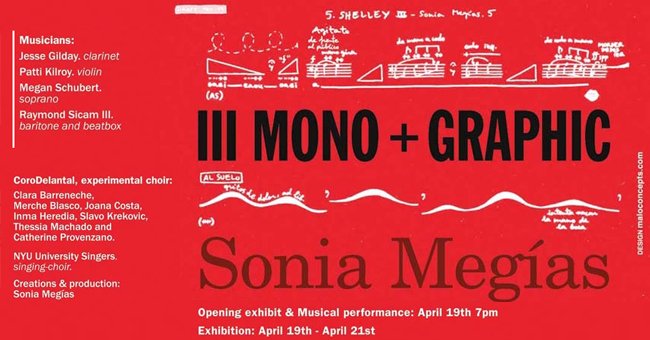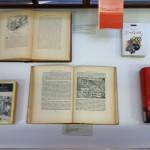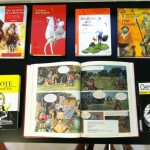Miguel de Cervantes en la biblioteca ICNY / Miguel de Cervantes in the ICNY library
La biblioteca ICNY organizó recientemente una exposición dedicada a Miguel de Cervantes con motivo del cuarto centenario de su muerte. Para ello seleccionamos de nuestros fondos obras originales, adaptaciones, traducciones, crítica literaria y biografías. Si quieres seguir conociendo más sobre la obra de Cervantes, el próximo 21 de julio inauguraremos en nuestra galería la exposición Quijotes por el mundo.
Enlaces recomendados:
http://www.bne.es/es/Colecciones/Cervantes/Quijote/
The Instituto Cervantes Library recently presented an exhibit in honor of the 400th anniversary of the death of Miguel de Cervantes. We prepared a selection of the original works, adaptations, translations, criticism and biographies. If you would like to learn more about the life and works of Cervantes, on 21 July we will celebrate the opening of the exhibit Quijotes por el mundo (Quijotes around the world) in our gallery.
Suggested links:
http://www.bne.es/es/Colecciones/Cervantes/Quijote/
Visibilidad de los Derechos Humanos en el Perú / Photojournalism: Oscar Medrano Pérez
Exposición / Exhibition
Auditorio ICNY- 20 al 31 de julio – Inauguración: 20 de julio, 6:00 pm
 Oscar Medrano Pérez nos aproxima, a través de 40 fotografías, a la cruda realidad por la fuerza de las imágenes captadas en relación a los acontecimientos históricos ocurridos en Perú, que confrontó la violencia interna y hoy ha vuelto a fortalecer la justicia, la integración efectiva de la paz y el respeto por los derechos humanos. El autor nos muestra las imágenes inolvidables de su trabajo durante cinco décadas, documentando la realidad y etapas de violencia ya superadas. Se podrá observar la destrucción y muerte en el período que afectó a la población peruana al cambiar su historia. Esta etapa, entre 1980 y 1990, se produjo con el surgimiento de Sendero Luminoso grupo terrorista al que el gobierno peruano logró reducir junto con otros. En la muestra se ven imágenes de esposas, madres e hijas que sufrieron la pérdida de sus seres queridos, así como de niños huérfanos, miembros de los comités de autodefensa (ronderos).
Oscar Medrano Pérez nos aproxima, a través de 40 fotografías, a la cruda realidad por la fuerza de las imágenes captadas en relación a los acontecimientos históricos ocurridos en Perú, que confrontó la violencia interna y hoy ha vuelto a fortalecer la justicia, la integración efectiva de la paz y el respeto por los derechos humanos. El autor nos muestra las imágenes inolvidables de su trabajo durante cinco décadas, documentando la realidad y etapas de violencia ya superadas. Se podrá observar la destrucción y muerte en el período que afectó a la población peruana al cambiar su historia. Esta etapa, entre 1980 y 1990, se produjo con el surgimiento de Sendero Luminoso grupo terrorista al que el gobierno peruano logró reducir junto con otros. En la muestra se ven imágenes de esposas, madres e hijas que sufrieron la pérdida de sus seres queridos, así como de niños huérfanos, miembros de los comités de autodefensa (ronderos).
El autor llegó a lugares casi inaccesibles del Perú tras los ataques, como Lucanamarca y Huaychao. Además, Medrano recoge imágenes no comunes en la sociedad: Peruanos que habitan en las altas cumbres andinas y las poblaciones selváticas, rostros inocentes de niños y niñas y ancianos descendientes de culturas ancestrales.
Organizan: Peruvian American Photojournalism Exhibition Committee 2012 e Instituto Cervantes NY. Comisario: Roberto Bustamante
Oscar Pérez Medrano leads us to the cruel reality on the strength of the images taken in relation to events which occurred in Peru’s history. During the 80s and 90s Peru confronted its internal violence and it recently has shifted to further justice, establishing an effective means for the integration of peace and respect for human rights.
The author shows us unforgettable images of his photographic work throughout five decades documenting the reality and stages of violence and overcome. The public will see a selection of impressive photos of destruction and death in the period of internal violence that affected the Peruvian people during this historical change, especially the Andean communities. This phase of violence during the 1980 and 1990 occurred with the emergence of Sendero Luminoso. The intervention of the Peruvian government successfully managed to reduce this and other terrorist groups with the capture of its top leaders.
In this exhibit the author shows some pictures of wives, mothers and daughters who suffered the loss of their loved ones, as well as orphaned children, members of self-defense committees (ronderos) that emerged during the years of political violence. The author went to places almost inaccessible inPeruafter the terrorist attacks such as the towns of Lucanamarca and Huaychau. The image of the wounded face of Edmundo Camana Sumari, one of the seven survivors of the slaughter of Lucanamarca became famous for his photo with a bandaged head covering his eye.
Furthermore, the author picks the other side of the coin of Peruvian reality with uncommon images of its society, portraying villagers of the high Andean peaks and forest populations, innocent faces of children, the elderly descendants of ancient cultures that are far from technological advances and lifestyles, a sector of the new generation of children, adolescents and women of the jungle region. There are portraits of enraged people, images of social conflicts, Andean traditional celebrations and cultural events.
Geografía postal / Postal Geography ‘Las postales de las familias García Lorca y De los Ríos’ Exposición / Exhibition
Instituto Cervantes – Galería ‘Amster Yard’
04 de junio – 07 de julio
 Esta exposición recoge la colección de 125 postales, escritas a mano en el reverso, que las familias García Lorca y De Los Ríos intercambiaron entre 1910 y 1960. La correspondencia cruzada entre las dos familias funciona como un registro intimista de la historia del siglo XX y fomenta un mayor conocimiento de la obra y vida de Federico García Lorca
Esta exposición recoge la colección de 125 postales, escritas a mano en el reverso, que las familias García Lorca y De Los Ríos intercambiaron entre 1910 y 1960. La correspondencia cruzada entre las dos familias funciona como un registro intimista de la historia del siglo XX y fomenta un mayor conocimiento de la obra y vida de Federico García Lorca
Mesa redonda / Round table: Las postales de la familia Lorca y De los Rios. 4 de junio. 7:00 pm con la actriz Laura García Lorca de los Ríos y la editora Cecilia Gandarias
La ruta de García Lorca en Nueva York
Lorca, así que pasen cien años
Organizan: Instituto Cervantes NY; Fundación Federico García Lorca; Pie Derecho y Fundación Caja Madrid
Exhibition
III Mono+Graphic. Concierto y Exposición / Concert & Exhibition
de Sonia Megías, compositora
con Jesse Gilday, clarinete; Patti Kilroy, violín; Megan Schubert, soprano; Raymond Sicam III, barítono y beatbox ; CoroDelantal, coro experimental : Clara Barreneche, Merche Blasco, Joana Costa, Inma Heredia, Slavo Krekovic, Thessia Machado y Catherine Provenzano ; NYU University Singers, coro cantor
19 – 21 de abril
Instituto Cervantes de Nueva York
 Una performance musical inaugurará la exposición a las 7:00 pm A musical performance will open the exhibition at 7:30 pm
Una performance musical inaugurará la exposición a las 7:00 pm A musical performance will open the exhibition at 7:30 pm
Gráficos que suenan, músicas pintadas, dibujos que se coreografían… intérpretes vestidos de monstruos, que maúllan, que llevan un collar de perro o que leen una partitura con las manos… ¡ No te pierdas el III MONO+GRAPHIC, celebrado en la galería, biblioteca y jardín de nuestro centro ! Dentro de Sonia Megías. III MONO+GRAPHIC – Concierto
Ibero-American Encounter / Encuentro Iberoamericano
Esposición / Exhibition
Centro Español – la Nacional, 239 west 14th St., NY
Inauguración-recepción el domingo / Opening Reception will be on Sunday, April 15th 3pm to 6pm.
Segunda recepción el miércoles / Second Reception will be on Wednesday, April 18th 6pm to 9pm.


